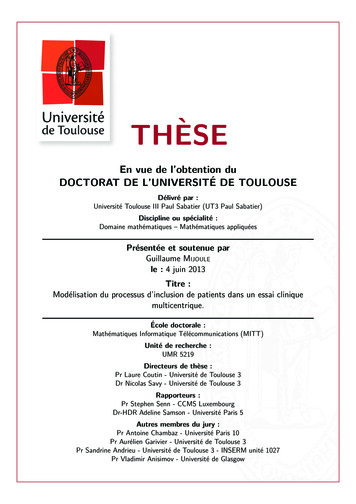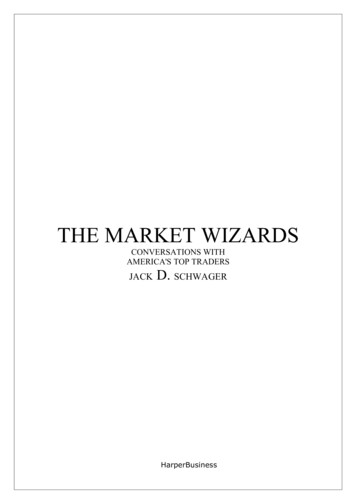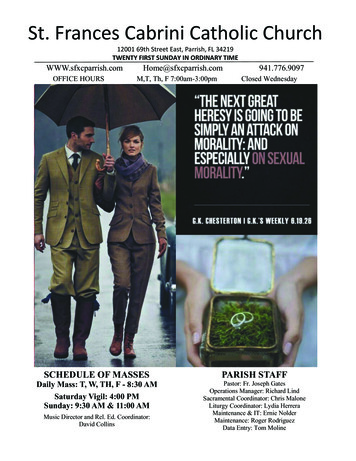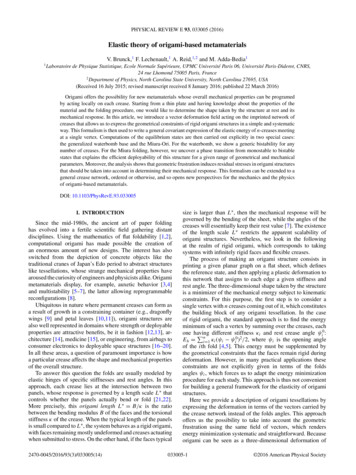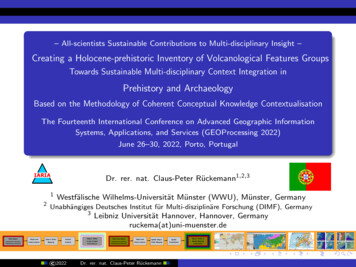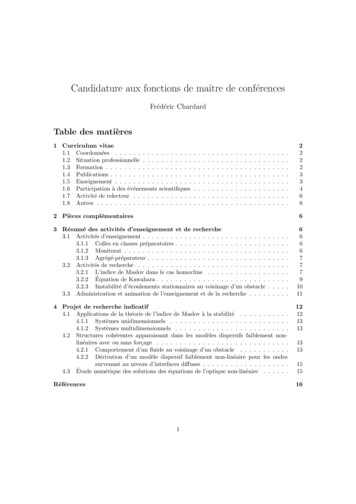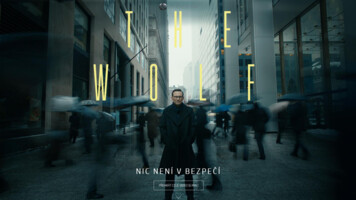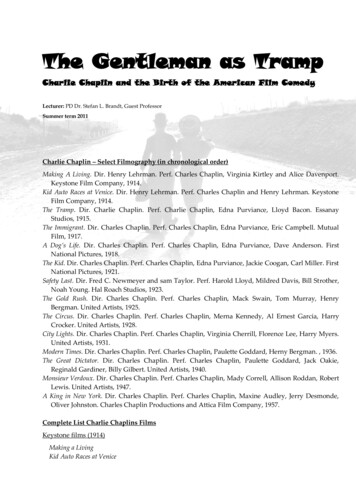
Transcription
The Gentleman as TrampCharlie Chaplin and the Birth of the American Film ComedyLecturer: PD Dr. Stefan L. Brandt, Guest ProfessorSummer term 2011Charlie Chaplin – Select Filmography (in chronological order)Making A Living. Dir. Henry Lehrman. Perf. Charles Chaplin, Virginia Kirtley and Alice Davenport.Keystone Film Company, 1914.Kid Auto Races at Venice. Dir. Henry Lehrman. Perf. Charles Chaplin and Henry Lehrman. KeystoneFilm Company, 1914.The Tramp. Dir. Charlie Chaplin. Perf. Charlie Chaplin, Edna Purviance, Lloyd Bacon. EssanayStudios, 1915.The Immigrant. Dir. Charles Chaplin. Perf. Charles Chaplin, Edna Purviance, Eric Campbell. MutualFilm, 1917.A Dog’s Life. Dir. Charles Chaplin. Perf. Charles Chaplin, Edna Purviance, Dave Anderson. FirstNational Pictures, 1918.The Kid. Dir. Charles Chaplin. Perf. Charles Chaplin, Edna Purviance, Jackie Coogan, Carl Miller. FirstNational Pictures, 1921.Safety Last. Dir. Fred C. Newmeyer and sam Taylor. Perf. Harold Lloyd, Mildred Davis, Bill Strother,Noah Young. Hal Roach Studios, 1923.The Gold Rush. Dir. Charles Chaplin. Perf. Charles Chaplin, Mack Swain, Tom Murray, HenryBergman. United Artists, 1925.The Circus. Dir. Charles Chaplin. Perf. Charles Chaplin, Merna Kennedy, Al Ernest Garcia, HarryCrocker. United Artists, 1928.City Lights. Dir. Charles Chaplin. Perf. Charles Chaplin, Virginia Cherrill, Florence Lee, Harry Myers.United Artists, 1931.Modern Times. Dir. Charles Chaplin. Perf. Charles Chaplin, Paulette Goddard, Herny Bergman. , 1936.The Great Dictator. Dir. Charles Chaplin. Perf. Charles Chaplin, Paulette Goddard, Jack Oakie,Reginald Gardiner, Billy Gilbert. United Artists, 1940.Monsieur Verdoux. Dir. Charles Chaplin. Perf. Charles Chaplin, Mady Correll, Allison Roddan, RobertLewis. United Artists, 1947.A King in New York. Dir. Charles Chaplin. Perf. Charles Chaplin, Maxine Audley, Jerry Desmonde,Oliver Johnston. Charles Chaplin Productions and Attica Film Company, 1957.Complete List Charlie Chaplins FilmsKeystone films (1914)Making a LivingKid Auto Races at Venice
Mabel s Strange PredicamentBetween ShowersA Film JohnnieTango TanglesHis Favorite PastimeCruel, Cruel LoveThe Star BoarderMabel at the WheelTwenty Minutes of LoveCaught in a CabaretCaught in the RainA Busy DayThe Fatal MalletHer Friend the BanditThe KnockoutMabel s Busy DayMabel s Married LifeLaughing GasThe Property ManThe Face on the Bar Room FloorRecreationThe MasqueraderHis New ProfessionThe RoundersThe New JanitorThose Love PangsDough and DynamiteGentlemen of NerveHis Musical CareerHis Trysting PlaceTillie s Punctured RomanceGetting AcquaintedHis Prehistoric PastEssanay films (1915-1918)His New JobNight Out, AThe ChampionIn The ParkA Jitney ElopementThe TrampBy the SeaWorkA WomanThe BankShanghaiedA Night in the ShowBurlesque on Carmen (released by Essanay in 1916 as Charlie Chaplin s Burlesque on Carmen)
PoliceTriple TroubleMutual films (1916-1917)The FloorwalkerThe FiremanThe VagabondOne A.M.The CountThe PawnshopBehind the ScreenThe RinkEasy StreetThe CureThe ImmigrantThe AdventurerFirst National (1918-1923)A Dog s LifeShoulder ArmsThe BondSunnysideA Day s PleasureThe KidThe Idle ClassPay DayThe PilgrimUnited Artists (1923-1952)A Woman of ParisThe Gold RushThe CircusCity LightsModern TimesThe Great DictatorMonsieur VerdouxLimelightAttica/ArchwayA King in New York (1957)A Countess from Hong Kong (1967)Secondary Texts on Charlie ChaplinBowman, William Dodgson. Charlie Chaplin: His Life and Art. New York: Haskell House, 1974.Capp, A. “The Comedy of Charlie Chaplin.” Atlantic Monthly (February 1950): 25-29.
Chambers, Colin. Here We Stand: Politics, Performers and Performance: Paul Robeson, Isadora Duncan andCharlie Chaplin. London: Nick Hern Books, 2006.Chaplin, Charlie. My Autiobiography. New York: Penguin Books, 1964.---. Charlie Chaplin: Interviews. Ed. Kevin J. Hayes. Jackson: University Press of Mississippi, 2005.---. My Trip Abroad. London and New York: Harper, 1922.Clausius, Claudia. The Gentleman is a Tramp: Charlie Chaplin’s Comedy. New York: Peter Lang, 1988.Conway, Michael, Gerald D. McDonald and Mark Ricci. The Films of Charlie Chaplin. New York:Citadel Press, 1965.Cotes, P. “The Little Fellow’s Self-Portrait.” Films and Filming, 2 December 1964.Daub, Adrian. “Hannah, Can You Hear Me? – Chaplin’s Great Dictator, ‘Schtonk,’ and theVicissitudes of Voice.” Criticism 51 (Summer 2009): 451-482.Friedman, Arthur B. and Harold Lloyd. “Interviews with Harold Lloyd.” Film Quarterly 15.4 (1962): 613.Florey, R. Charlie Chaplin. Paris: Jean Pascal, 1927.Galanopoulos, Kostas. “How Contemporary are Charlie Chaplin’s ‘Modern Times’? The Fordist andPost-Fordist Production Models.” Intellectum 3 (November 2007-March 2008).Gehring, Wes D. Charlie Chaplin: A Bio-Bibliography. Westport: Greenwood Press, 1983.Gifford, D. Chaplin. Garden City: Doubleday Ltd, 1974.Haining, Peter, ed. Charlie Chaplin: A Centenary Celebration. London and New York: Foulsham, 1989.Harness, Kyp. The Art of Charlie Chaplin: A Film-by-film Analysis. Jefferson: McFarland & Co, 2008.Huff, T. Charlie Chaplin. New York: Henry Schuman, 1951.Kamin, Dan. The Comedy of Charlie Chaplin: Artistry in Motion. Lanham: Scarecrow Press, 2008.Kimber, John. The Art of Charlie Chaplin. Sheffield, UK: Sheffield Academic Press, 2000.Kuriyama, Constance Brown. “Chaplin’s Impure Comedy: The Art of Survival.” Film Quarterly 45.3(1992): 26-38.Lahue, K. C. and T. Brewer. Kops and Custards: The Legend of Keystone Films. Norman: University ofOklahoma Press, 1968.Larcher Jerome. Charlie Chaplin. Paris: Cahiers du Cinema Sarl, 2011.Lieberman, Evan A. “Charlie the Trickster.” Journal of Film and Video 46.3 (1994): 16-28.Lynn, Kenneth Schuyler. Charlie Chaplin and His Times. New York: Simon & Schuster, 1997.Lyons, Timothy J. Charles Chaplin: A Guide to References and Resources. London: Prior, 1979.Manvell, R. Chaplin. Boston: Little & Brown, 1974.Martin, M. Charlie Chaplin. Paris: Seghen, 1966.Mccabe, John. Charlie Chaplin. Garden City: Doubleday, 1978.McCaffrey, D. W. ed. Focus on Chaplin. New Jersey: Prentice Hall, Inc, 1971.---. 4 Great Comedians: Chaplin, Lloyd, Keaton, Langdon. New York: A. S. Barnes & Co, 1968McDonald, G. D. The Picture of History of Charlie Chaplin. New York: Nostalgia Press, 1965.---. et al, eds. The Films of Charlie Chaplin. New York: Bonanza Books, 1965.McVay, D. “A Proper Charlie.” Films and Filming. 2. November (1964).Meryman, R. “Chaplin: An Interview by Richard Meryman.” Life (10 March 1967): 82-84 & 88-94.Mitry, J. Tout Chaplin. Paris: Seghers, 1972.Nysenholc, Adolphe, ed. Charlie Chaplin: His Reflection in Modern Times. Berlin and New York: Moutonde Gruyter, 1991.Maltin, Leonard. The Great Movie Comedians: From Charlie Chaplin to Woody Allen. New York: CrownPublishers, 1978.Milton, Joyce. Tramp: The Life of Charlie Chaplin. New York: HarperCollins, 1996.Payne, R. The Great Charlie: A Biography of the Tramp. London: Andre Deutsch Ltd, 1952.Pells, Richard H. Modernist America: Art, Music, Movies, and the Globalization of American Culture. NewHaven: Yale University Press, 2011.
Quigly, Isabel. Charlie Chaplin: Early Comedies. London: Studio Vista, 1968.Robinson, D. His Life and Art. London: Paladin Grafton Books, 1986.---. Chaplin: The Mirror of Opinion. London: Secker & Warburg, 1984.Sbardellati, John and Toni Shaw. “Booting a Tramp: Charlie Chaplin, the FBI, and the Construction ofthe Subversive Image in Red Scare America.” Pacific Historical Review 72.4 (2003): 495-530.Schickel, Richard, ed. The Essential Chaplin: Perspectives on the Life and Art of a Great Comedian. Chicago:Dee, 2006.Sennett, Mack, as told to Cameron Shipp. King of Comedy. New York: Doubleday, 1964.Seidman, S. Comedian Comedy: A Tradition in Hollywood Film. UMI Research Press, 1979.Smith, A. E. and P. Koury. Two Reels and a Crank. New York: Doubleday and Co, 1952.Sobel, R. and David Francis. Chaplin: Genesis of a Clown. London: Quartet Books, 1977.Tyler, P. Chaplin: Last of the Clowns. n.p: Vanguard Press, Inc, 1947.Weales, G. Canned Goods As Caviar: American Film Comedy of the 1930s. Chicago and London:University of Chicago Press, 1985.Vance, Jeffrey. “The Circus: A Chaplin Masterpiece.” Film History. 8.2 (1996): 186-208.General Texts on Slapstick and ComedyBergson, H. Laughter: An Essay on the Meaning of the Comic. Trans. C. Brereton and F. Rothwell.London: Macmillan, 1935.Brecht, Berthold. Brecht on Theatre: The Development of Aesthetic. Trans. J. Willet. London: Methuen,1964.Burke, K. A Grammar of Motives. Berkeley: University of California Press, 1969.Byrge, Duane and Robert Milton Miller. The Screwball Comedy Films: A History and Filmography.Jefferson, NC: McFarland, 1991.Byron, S. and E. Weis, eds. The National Society of Film Critics on Movie Comedy. New York: PenguinBooks, 1977.Dale, Alan S. Comedy Is a Man in Trouble: Slapstick in American Movies. Minneapolis, MN: University ofMinnesota Press, 2000.De Nitto, D. and W. Herman. Film and the Critical Eye. New York: Macmillan, 1975.Durgnat, R. The Crazy Mirror: Hollywood Comedy and the American Image. New York: Horizon Press,1970.Eastman, M. The Sense of Humor. New York: Charles Scribner’s Sons, 1922.Frye, N. Anatomy of Criticism: Four Essays. Princeton and New Jersey: Princeton University Press, 1973.Garbiez, A. and J. Klinowski. Cinema the Magic Vehicle: A Guide to its Achievement. New Jersey:Scarecrow Press Ltd, 1975.Garbiez, H. M, ed. Authors on Film. London: Indiana University Press, 1972.Gehring, Wes D. Romantic vs. Screwball Comedy: Charting the Difference. Lanham, MD: Scarecrow Press,2002.---. Screwball Comedy: A Genre of Madcap Romance. Westport, CT: Greenwood Press, 1986.---. Screwball Comedy: Defining a Film Genre. Muncie, IN: Ball State University, 1983.Goldoni, C. The Comic Theatre. Lincoln: University of Nebraska Press, 1969.Grote, D. The End of Comedy: The Sit-Com and the Comedic Tradition. Hamden: Archon Books, 1983.Harvay, James : Romantic Comedy in Hollywood, from Lubitsch to Sturges. New York, 1987.Hermsdorf, Daniel. Billy Wilder: Filme – Motive – Kontroverses. Bochum: Paragon-Verlag, 2006.Havel, V. “The Anatomy of the Gag.” Modern Drama. 23. (March 1980): 13-24.Jordan, T. H. The Anatomy of Humor: With an Essay on the Marx Brothers. New York: Revisionist Press,1975.Karasek, Hellmuth. Billy Wilder: Eine Nahaufnahme. Hamburg: Hoffmann und Campe, 2006.
Karnick, Kristine Brunovska, ed. Classical Hollywood Comedy. New York: Routledge, 1995.Keaton, Buster. My Wonderful World of Slapstick. Ed. Charles Samuels. New York, NY: Da Capo Press,1960King, Rob and Tom Paulus, eds. Slapstick Comedy. New York, NY: Routledge, 2010.Knapp, Raymond. The American Musical and the Perfomance of Personal Identity. Princeton, NJ et al:Princeton Univ. Press, 2009.Kerr, W. The Silent Clowns. New York: Alfred A. Knopf, 1975.---. World of Laughter: The Motion Picture Comedy Short, 1910-1930. Tulsa: University of Oklahoma Press,1966.Mast, G. The Comic Mind: Comedy and the Movies. New York: Bobbs-Merrill Co. Inc, 1973.McDonald, Tamar Jeffers. Romantic Comedy: Boy Meets Girl Meets Genre. London, UK and New York,NY: Wallflower, 2007.Meade, Marion. Lonelyhearts: The Screwball World of Nathanael West and Eileen McKenney. Boston, MA:Houghton Mifflin Harcourt, 2010.Meredith, G. An Essay on Comedy and the Uses of the Comic Spirit. London: Archibald Constable & Co.Ltd, 1905.Montgomery, J. Comedy Films: 1894-1954. London: George Allen & Unwin Ltd, 1954.Muecke, D. C. The Compass of Irony. London: Methuen & Co. Ltd, 1969.---. Irony and the Ironic. London and New York: Methuen, 1982.Robinson, D. The Great Funnies: A History of Film Comedy. New York: Dutton, 1969.Sarris, A, ed. Interviews with Film Directors. New York: Bobbs-Merrill Co., Inc, 1967.Sikov, Ed. Screwball: Hollywood’s Madcap Romantic Comedies. New York, NY: Crown Publishers, 1989.Secondary Materials on Film History and Film Theory (General Texts)Allen, Nancy. Film Study Collections: A Guide to Their Development and Use. New York: Ungar, 1979.Bazin, André. “Theater and Cinema.” (From What Is Cinema?) 1951. Film Theory and Criticism.Introductory Readings. Ed. by Mast, Gerald, Marshall Cohen and Leo Braudy. New York andOxford: Oxford Univ. Press, 1992: 375-86.Beach, Christopher. Class, Language, and American Film Comedy. Cambridge: Cambridge Univ.Press, 2002.Beaver, Frank Eugene. Dictionary of Film Terms: The Aesthetic Companion to Film Analysis. New York:Twayne Publishers: London Prentice Hall, 1994.Bordwell, David. Making Meaning: Inference and Rhetoric in the Interpretation of Cinema. Cambridge,MA: MIT Press, 1991.---, Janet Staiger & Kristin Thompson. The Classical Hollywood Cinema. New York: Columbia UniversityPress, 1985.---, and Kristin Thompson. Film Art. An Introduction. 1979. New York, St. Louis, San Francisco et al:McGraw-Hill, 5th. ed., 1997.---. “Intensified Continuity: Visual Style in Contemporary American Film.” Film Quarterly 55.3 (2002):16-28.---. Narration in the Fiction Film. London: Routledge 1985.---. On the History of Film Style. Cambridge, MA: Harvard University Press, 1997.Braudy, Leo, ed. Film Theory and Criticism: Introductory Readings. New York: Oxford University Press,1999.Butsch, Richard. The Making of American Audiences. Cambridge: Cambridge University Press, 2000.Carroll, Noël. Interpreting the Moving Image Cambridge: Cambridge University Press, 1998.---. Mystifying Movies. Fads & Fallacies in Contemporary Film Theory. New York: Columbia UniversityPress, 1988.
---. Philosophical Problems of Classical Film Theory. Princeton, N.J.: Princeton University Press, 1988.Charney, Leo and Vanessa A. Schwartz, eds. Cinema and the Invention of Modern Life. Berkeley: U ofCalifornia P, 1995.Chatman, Seymour. Story and Discourse: Narrative Structure in Fiction and Film. Ithaca: CornellUniversity Press, 1978.Christensen, Terry. Reel Politics: American Political Movies from Birth of a Nation to Platoon. New York,NY: Blackwell, 1987.Cook, David A. A History of Narrative Film. New York: W.W. Norton & Company, 1981.Drummond, Lee: American Dreamtime: A Cultural Analysis of Popular Movies, and Their Implications for aScience of Humanity. Lanham, Md.: Littlefield Adams, 1996.Eisenstein, Sergei. “A Dialectical Approach to Film Form” Film Form. New York: Harcourt Brace,1977: 45-63.---. Film Essays and a Lecture. Trans. J. Leyda. New York: Praeger Publ, 1970.---. Notes of a Film Director. Moscow: Foreign Languages Publ. House, 1957.---. The Film Sense. Trans. J. Leyda. New York: Harcourt, Brace & World, Inc, 1942.Franklin, J. Classics of the Silent Screen. New York: Citadel Press, 1959.Fuery, Patrick. New Developments in Film Theory. New York: St. Martin’s Press, 2000.Giroux, Henry A. Breaking in to the Movies: Film and the Culture of Politics. Malden, MA: Blackwell,Publishers, 2002.Grodal, Torben K. Moving Pictures: A New Theory of Film Genres, Feelings, and Cognition. Oxford, UKand New York, NY: Clarendon Press Oxford University Press, 1997.Hansen, Miriam. Babel and Babylon: Spectatorship in American Silent Film. Cambridge, MA: HarvardUP, 1991.Harrah, David. “Aesthetics of the Film: The Pudovkin-Arnheim-Eisenstein Theory.” The Journal ofAesthetics and Art Criticism 13.2 (1954): 163-74.Hayward, Susan. Key Concepts in Cinema Studies. London and New York: Routledge, 1996.Hill, John, and Pamela Church Gibson, eds. Film Studies: Critical Approaches. Oxford et al: OxfordUniv. Press, 2000.History of the American Cinema. New York: Maxwell Macmillan International, 1990- vols. 1-6, 8-10.Ifkovic, Edward. “Some Notes on the Ethnic Dimension in the Silent Film.“ MELUS 4.2 (1977): 13-14.Kaplan, E. Ann. Psychoanalysis & Cinema. New York: Routledge, 1990.Katz, Ephraim. The Film Encyclopedia. 4th Ed. New York, N.Y.: Harper Perrenial, 2001.Keil, Charlie. Early American Cinema in Transition: a Story, Style, and Filmmaking, 1907 – 1913. Madison,Wis. et al.: Univ. of Wisconsin Press, 2001.Knight, Deborah. “Back to Basics: Film/Theory/Aesthetics.” Journal of Aesthetic Education 31.2 (1997):37-44.Knapp, Raymond. “Reconsidering Film Theory and Method.” New Literary History 24.2 (1993):321-38.Konigsberg, Ira. The Complete Film Dictionary. New York: New American Library, 1987.Kracauer, Siegfried. “The Mass Ornament.” The Mass Ornament: Weimar Essays. Ed, and Trans.Thomas Y. Levine. Cambridge: Harvard University Press, 1995: 75-86.---. Theorie des Films: Die Errettung der Aeußeren Wirklichkeit. Frankfurt am Main,1996. [engl. Theory ofFilm: The Redemption of Physical Reality. New York: Oxford University Press, 1974.Lapsley, Robert, & M. Westlake. Film Theory: An Introduction. Manchester: Manchester UniversityPress, 1988.Locke, Brian. Racial Stigma on the Hollywood Screen from World War II to the Present: The OrientalistBuddy Film. New York, NY: Palgrave Macmillan, 2009.Lotman, Jurij M. Probleme der Kinoästhetik. Einführung in die Semiotik des Films. Frankfurt/M: Syndikat,1977.Maltby, Richard & Ian Craven. Hollywod Cinema: An Introduction. Cambridge: Blackwell, 1995.
Margoris, Harriett Elaine. The Cinema Ideal: An Introduction to Psychoanalytic Studies of the FilmSpectator. New York: Garland, 1988.Matzker, Reiner. Das Medium der Phänomenalität: Wahrnehmungs- und erkenntnistheoretische Aspekte derMedientheorie und Filmgeschichte. München: Fink, 1993.Mayne, Judith. Cinema and Spectatorship. London: Routledge, 1993.Metz, Christian. ---. Essais Sur la Signification au Cinéma I. Paris: Klincksieck, 1968.[dt.: Semiologie des Films. München: Fink 1972]---. Essais sur la Signification au Cinéma II. Paris: Klincksieck, 1972.---. Essais sur la Signification au Cinéma, t. 1, 2. Paris: Klincksieck. 1981.---., and Alfred Guzzetti. “The Fiction Film and its Spectators: A Metapsychological Study.” NewLiterary History 8.1 (1976): t.: Sprache und Film. Frankfurt/M.: Athenäum 1973]---. "Le signifiant imaginaire". Communications 23 (1975): 3-55 [engl. "The Imaginary Signifier". Screen16(2): raled'Éditions,1977.[engl. The Imaginary Signifier. Psychoanalysis and the Cinema. Bloomington: Indiana University Press1982; dt. Der Imaginäre Signifikant. Psychoanalyse und Kino ( Film und Medien in der Diskussion. 9).Münster: Nodus 2000 is:Méridiens,1991[dt. Die unpersönliche Enunziation, oder, Der Ort des Films ( Film und Medien in der Diskussion. 6).Münster: Nodus, 1997]---. “Photography and Fetish.” October 34 (1985): 81-90.---. Psychoanalysis and Cinema: The Imaginary Signifier. London: MacMillan, 1982.Metz, Walter. Engaging Film Criticism: Film History and Contemporary American Cinema. New York: P.Lang, 2004.McClure, Arthur F. Research Guide to Film History. Saratoga, CA.: R & E Pub, 1983.McLaughlin, Robert L. We’ll Always Have the Movies: American Cinema During World War II. Lexington,KY: University Press of Kentucky, 2006.Miller, Toby, and Robert Stam, eds. A Companion to Film Theory Malden, MA: Blackwell, 1999.---, and Robert Stam, eds. Film and Theory: An Anthology. Malden, Mass.: Blackwell Publishers, 2000.Monaco, James. How to Read a Film. 2nd ed. New York: Oxford Univ. Press, 1980. [dt. Film Verstehen.Reinbek b. Hamburg: Rowohlt 1980/1995] .Neale, Steve. Genre and Hollywood. London & New York, NY: Routledge, 2000.Nichols, Bill. Ideology and the Image. Social Interpretation in the Cinema and Other Media. Bloomington:Indiana Univ. Press, 1981.Nowell-Smith, Geoffrey. Oxford History of World Cinema. Oxford & New York: Oxford UniversityPress, 1996.Pearson, Roberta. E., and P. Simpson, eds. Critical Dictionary of Film and Television Theory. LondonNew York: Routledge, 2001.Peters, Jan M. Pictorial Signs and the Language of Film. Amsterdam: Rodopi, 1981.---. Scenes of Instruction: The Beginnings of the U.S. Study of Film. Berkeley: Univ. of California Press,2007.Rodowick, D.N., ed. Afterimages of Gilles Deleuze’s Film Philosophy. Minneapolis, MN: University ofMinnesota Press, 2010.Rosen, Philip, ed. Narrative, Apparatus, Ideology: A Film Theory Reader. New York: Columbia Univ.Press, 1986.Shaviro, Steven. The Cinematic Body. Minneapolis: The Univ. of Minnesota Press, 1993.
Scheurer, Timothy E. Music and Mythmaking in Film: Genre and the Role of the Composer. Jefferson, N.C.:McFarland, 2008.Schlüpmann, Heide, and Jeremy Gaines. “The Subject of Survival: On Kracauer’s Theory of Film.”New German Critique 54 (1991): 111-26.Slide, Anthony. The New Historical Dictionary of the American Film Industry. Lanham, MD.: ScarecrowPress, 1998.Sobchak, Vivian. The Address of the Eye: A Phenomenology of Film Experience. Princeton, NJ: PrincetonUniversity Press, 1992.Sontag, Susan. “Film and Theatre.” 1966. Film Theory and Criticism. Introductory Readings. Ed. by Mast,Gerald, Marshall Cohen and Leo Braudy. New York and Oxford: Oxford Univ. Press, 1992: 362-74.Staiger, Janet. Interpreting Films: Studies in the Historical Reception of American Cinema. Princeton, NJ:Princeton University Press, 1992.Tucker, Patrick. Secrets of Screen Acting. New York and London: Routledge, 1994.Williams, Linda, ed. Viewing Positions: Ways of Seeing Film. New Brunswick, NJ: Rutgers UP, 1995.---. “When the Woman Looks.” 1984. Film Theory and Criticism: Introductory Readings. Ed. by Mast,Gerald, Marshall Cohen and Leo Braudy. New York and Oxford: Oxford Univ. Press, 1992: 561577.Wyatt, Justin. High Concept: Movies and Marketing in Hollywood. Austin, TX: University of Texas Press,1994.Zucker, Carole, ed. Making Visible the Invisible: An Anthology of Original Essays on Film Acting.Metuchen, N. J., and London: The Scarecrow Press, 1990.
The Gentleman as Tramp Charlie Chaplin and the Birth of the American Film Comedy Lecturer: PD Dr. Stefan L. Brandt, Guest Professor Summer term 2011 Charlie Chaplin - Select Filmography (in chronological order) Making A Living.


